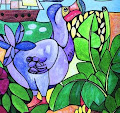We caught Lalla Essaydi exhibition at the National Museum of African Art in Washington DC. Essaydi's a Moroccan-born photographer living in New York and is making an impact with her amazingly beautiful art which depicts Muslim women living under Shariah or Islam.
No matter how many different explanations Essaydi gives for her work which has a patina of Arabic text scrawled all over it, her unique work speaks for itself and conveys a story that is far from what Essaydi the cowardly but talented painter wants us to believe is the inspiration that spawned the works. The written word from the false book known as the koran, written by madmen, is the tool for keeping Muslim women locked up in cages .... and to anyone with a clear eye, that is what Essaydi has shown by the patina of Arabic calligraphy on each and every painting. It's the written word ...it's the Arabic calligraphy. In some paintings the text look like prison walls with tiny openings just like the tiny openings for the eyes for women wearing burkhas. Every painting where a woman is portrayed is painted to look like she is imprisoned behind a wall of Arabic lettering.
I put my perception of her paintings to my travelling companion Kia for her reaction and she agreed with me that Essaydi is the kind of person who ddn't want to create any waves by speaking out against the Muslim mentality that imprisons women from birth to death and maybe even beyond. That's two against your false explanation, Ms Essaydi. Grow a straighter spine, girl... keeping your feet in two boats will tear you apart sooner than you think.
The supposedly "feminist" artist says this about her work: "In my art, I wish to present myself through multiple lenses -- as artist, as Moroccan, as Saudi, as traditionalist, as Liberal, as Muslim. In short, I invite the viewer to resist stereotypes.”
And, this;
The traditions of Islam exist within spatial boundaries. The presence of men defines public space, the streets, the meeting places. Women are confined to private spaces, the architecture of the homes. In these photographs, I am constraining women within space, confining them to their "proper" place, a place bounded by walls and controlled by men. Their confinement is a decorative one. The women, then, become literal with this visual confinement, I recall literal confinements. The house in the photographs is a large, unoccupied house belonging to my extended family. When a young woman disobeyed, stepped outside the permissible space, she was sent to this house. Accompanied by servants, but spoken to by no one, she would spend a month alone. In this silence, women can only be confined visions of femininity. In photographing women inscribed with henna, I emphasize their decorative role, but subvert the silence of confinement. These women "speak" visually to the house and to each other, creating a space that is both hierarchical and fluid. Furthermore, the calligraphic writing, a sacred Islamic art form, inaccessible to women, constitutes an act of rebellion.
Applying such writing in henna, a form of adornment considered "women’s work," further underscores the subversiveness of the act. In this way, the calligraphy in the images is one of a number of visual signs that carry a double meaning. As an artist now living in the West, I have become aware of another space, besides the house of my girlhood, an interior space, one of "converging territories." I will always carry that house within me, but my current life has added other dimensions. There is the very different space I inhabit in the West, a space of independence and mobility. It is from there that I can return to the landscape of my childhood in Morocco, and consider these spaces with detachment and new understanding. When I look at these spaces now, I see two cultures that have shaped me and that are distorted when looked at through the "Orientalist" lens of the West. Thus the text in these images is partly autobiographical. In it, I speak of my thoughts and experiences directly, both as a woman caught somewhere between past and present, as well as between "East" and "West," and also as an artist, exploring the language in which to "speak" from this uncertain space.
And, then comes this:
“My message would be: Arab women are not so much oppressed as the Western World thinks. We are women incredibly engaged in our lives, to have a better life,”
Talk about a split personality !!! Let's hope her work is bought by many more of those Arab millionaires who are presumably her biggest clients. She knows how to sell her artwork by not displeasing anyone. Money, money, money .... makes the world go round.



No comments:
Post a Comment
Note: Only a member of this blog may post a comment.